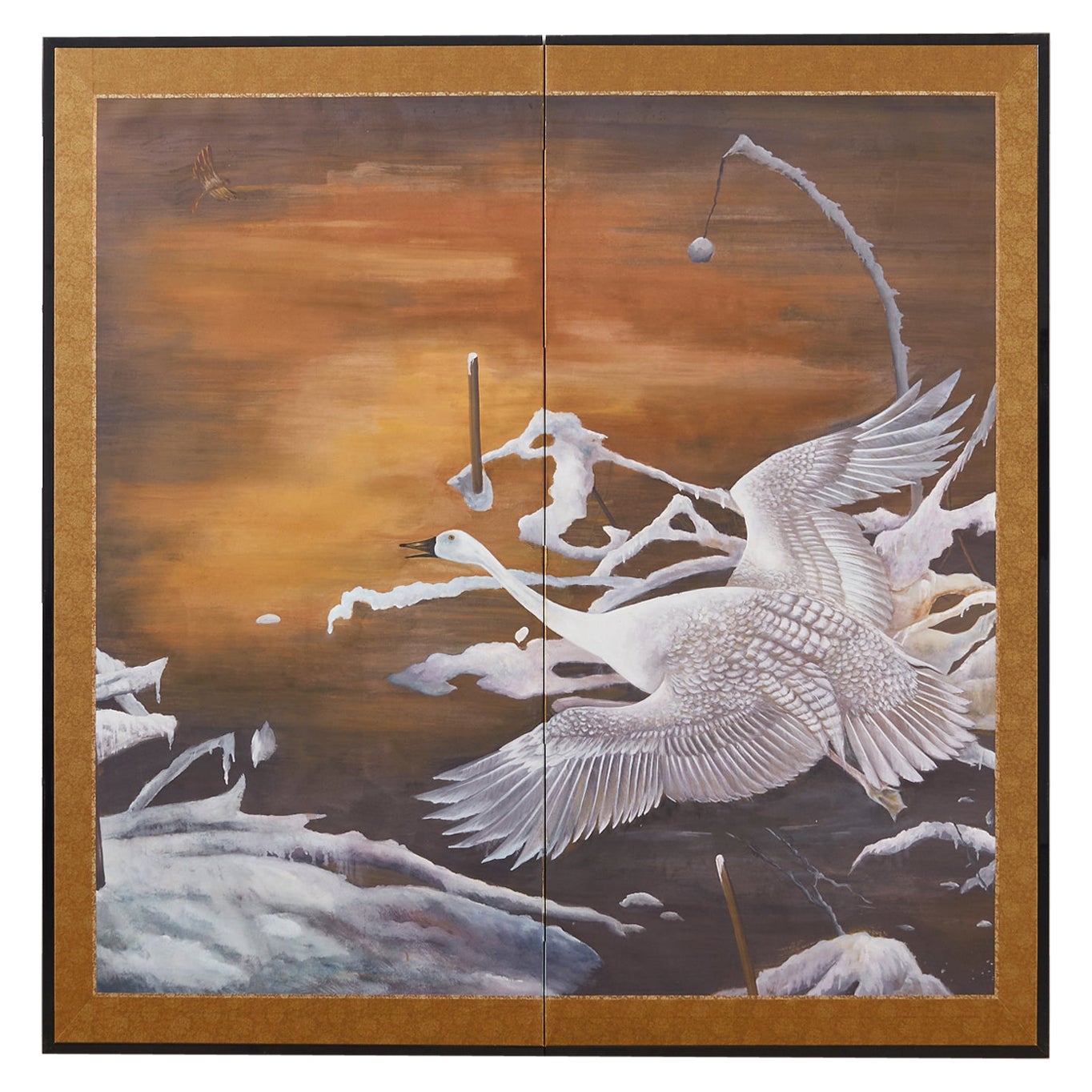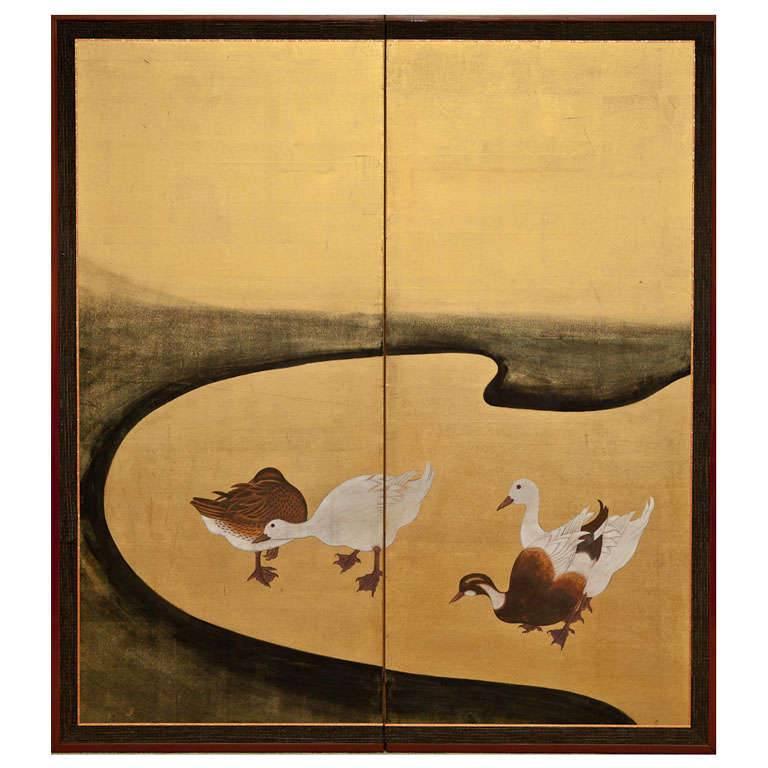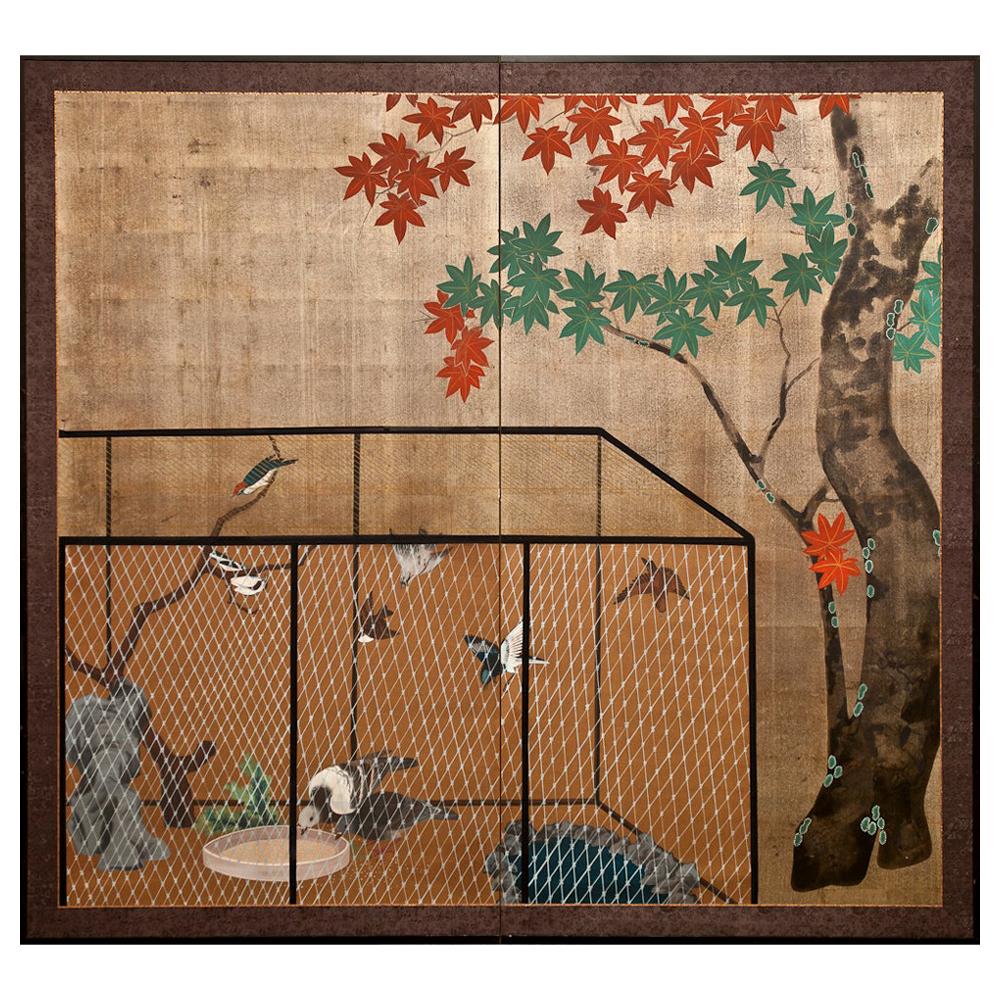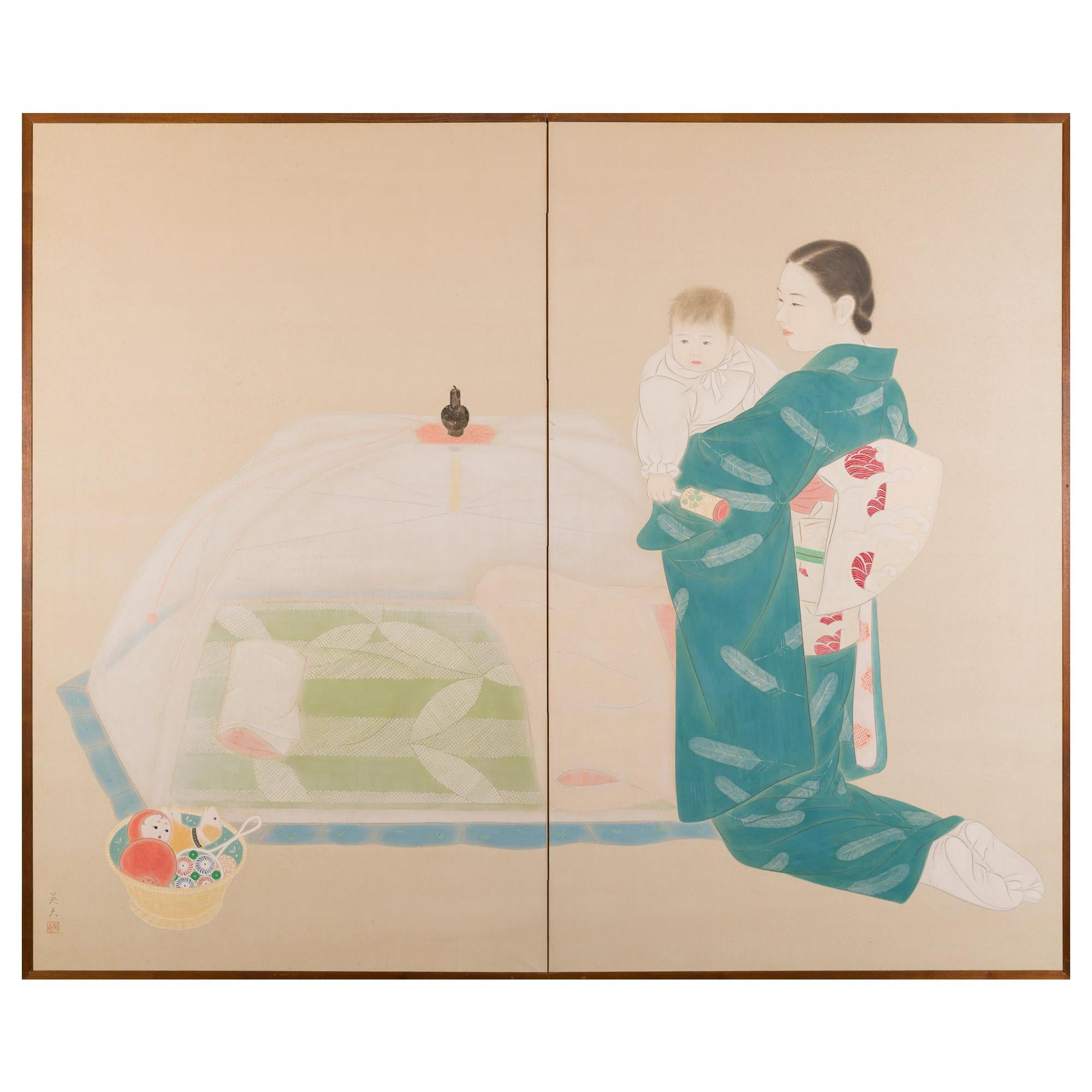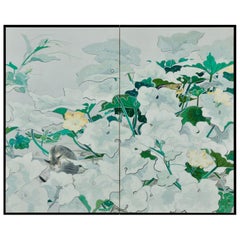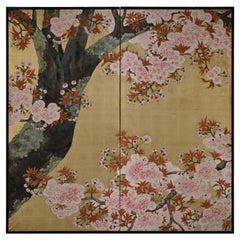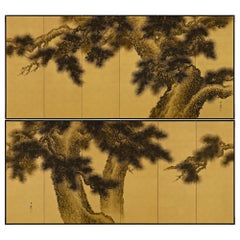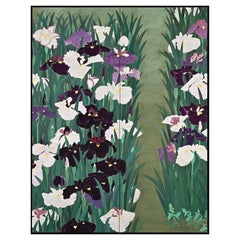
Two-panel Japanese Screen, 1954 Inten Exhibition Nihonga, June Irises
View Similar Items
Want more images or videos?
Request additional images or videos from the seller
1 of 10
Two-panel Japanese Screen, 1954 Inten Exhibition Nihonga, June Irises
About the Item
- Dimensions:Height: 90 in (228.6 cm)Width: 69.5 in (176.53 cm)Depth: 0.75 in (1.91 cm)
- Style:Showa (Of the Period)
- Materials and Techniques:
- Place of Origin:
- Period:
- Date of Manufacture:1954
- Condition:Refinished. Wear consistent with age and use. Restored and remounted in Kyoto utilizing traditional craftsmen and techniques.
- Seller Location:Kyoto, JP
- Reference Number:1stDibs: LU2472327433962
About the Seller
5.0
Recognized Seller
These prestigious sellers are industry leaders and represent the highest echelon for item quality and design.
Established in 2001
1stDibs seller since 2016
60 sales on 1stDibs
Typical response time: 11 hours
More From This SellerView All
- Japanese Screen Painting, Cat & Pumpkin Patch. Showa Era, 1940sLocated in Kyoto, JPChuichi Konno (1915-2006) Cat and Pumpkin Patch Showa period, 1940s. Folding screen in two-panels. Painted on paper with mineral pigments and gofun. Sign: Chuichi Sea...Category
Vintage 1940s Japanese Showa Paintings and Screens
MaterialsPaper, Wood
- Early 20th Century Japanese Cherry Blossom Screen by Kano SanrakukiLocated in Kyoto, JPCherry Blossoms Kano Sanrakuki (1898-1981) Showa period, circa 1930 2-panel Japanese Screen Color, gofun and gold leaf on paper Against a backdrop of gold-leafed ground, the lichen covered trunk and branches of the life-sized cherry blossom tree reach out and beyond the confines of the pictorial surface. The overall composition has a feeling of flatness which draws emphasis to the surface and the three-dimensionality of the cherry blossoms. Painstakingly built-up layers of thickly applied shell-white gofun detail the voluminous blossoms and cover large areas of this tour-de-force of Japanese Nihonga painting. By simplifying the background, minimizing the number of colors and depicting the blossoms with such heavy relief, the artist has emphasized the stunning presence of the cherry tree. The type of tree depicted is the Yae-Zakura; a double-layered type of cherry blossom famed for its beauty and strength. When we think of Japanese cherry blossoms, the first thing that comes to mind is Somei Yoshino variety, which has a single flower with five almost white petals. This type is fragile and easily blown away by strong wind or rain. Most of the double-flowered cherry blossoms begin to bloom when the Somei-Yoshino falls, and the flowering period lasts longer than that of the Somei-Yoshino. Kano Sanrakuki originally studied painting at the Kyoto City Arts and Crafts School under the tutelage of Yamamoto Shunkyo...Category
Early 20th Century Japanese Showa Paintings and Screens
MaterialsGold Leaf
- Early 20th Century Japanese Screen Pair - Ink Pine Trees on GoldLocated in Kyoto, JPImao Keisho (1902-1993) Pine Trees Early 20th Century, Circa 1930 Pair of six-panel Japanese screens. Ink on silk and gold leaf. Dimensions: Each screen H. 67.5” x 148” (172 cm x 376 cm) A pair of monumental six-panel Japanese pine screens by the renowned Nihonga artist Imao Keisho. Here Keisho entirely removed the background and brought the pine trees to the surface of the painting. This simplification of the elements makes the scene exceptionally direct and compelling and injects a very modern...Category
Early 20th Century Japanese Showa Paintings and Screens
MaterialsGold Leaf
- circa 1930 Japanese Silver Screens by Isoi Joshin, Flowers of the Four SeasonsLocated in Kyoto, JPFlowers of the four seasons Isoi Joshin (1883-1964) Pair of six-panel Japanese screens Ink, pigment, lacquer and silver leaf on pa...Category
Mid-20th Century Asian Showa Paintings and Screens
MaterialsSilver Leaf
- 17th Century Japanese Screen Pair, CranesLocated in Kyoto, JPCranes Anonymous, Kano School. Edo period, second half of the 17th century. Pair of six-panel screens. Ink, pigment gofun and gold l...Category
Antique 1670s Japanese Edo Paintings and Screens
MaterialsGold Leaf
$85,000 / set - Japanese Screen Painting, circa 1700 'Horses' by Kano TanshinLocated in Kyoto, JPHorses Kano Tanshin Morimasa (1653-1718) Two-panel tea-ceremony Japanese screen or furosaki Ink on gold leaf, late 17th-early 18th century Measures: H 55 cm x W 182 cm The Kano school was closely aligned with the warrior class in Japan. The samurai, who lived in a closed and rigid hierarchical society established by the Shogunate, were drawn to the energy and freedom horses symbolize; Kano school artists commonly depicted the equine creatures as they are here, in unfettered and carefree family groups. China originally introduced horse paintings to Japan; the works typically focused on capturing the essence of horses in their various environments and often involved integrating human figures into the images. Kano Tanshin Morimasa (1653-1718) was the son of Kano Tanyu...Category
Antique 1690s Japanese Edo Paintings and Screens
MaterialsGold Leaf
You May Also Like
- Japanese Two-Panel Screen Spring FlowersLocated in Hudson, NYA vibrant celebration of spring using a colorful ensemble of coxcomb, irises, lilies, hybiscus, and a blossoming cherry tree. Great examples of "tarashikomi" or "painting-in", a Rim...Category
Vintage 1930s Japanese Showa Paintings and Screens
MaterialsSilk, Paper
- Japanese Two Panel Screen Moon ViewingLocated in Hudson, NYJapanese two panel screen: Moon Viewing, painting of two noblewomen admiring the full moon outdoors. Extremely sophisticated execution of painting ove...Category
Vintage 1970s Japanese Showa Paintings and Screens
MaterialsSilk, Wood, Paper
- Japanese Two Panel Screen Nihonga Style Painting of Children in Western DressLocated in Hudson, NYBeautiful soft painting of mineral pigments and ink on paper with a silk brocade border.Category
Early 20th Century Japanese Paintings and Screens
MaterialsBrocade, Silk, Paper
- Japanese Two Panel Screen, TurkeysLocated in Hudson, NYMineral pigments on silk, mounted on a gold panel, in silk border. Signature and seal read: Yoho.Category
Early 20th Century Japanese Paintings and Screens
MaterialsSilk
- Japanese Two Panel Screen, ChrysanthemumsLocated in Hudson, NYBeautiful white chrysanthemums are emphasized by heavy gold on a soft floral landscape, while gold clouds create a striking and dream-like floral scene. Gold leaf and gofun with min...Category
Antique Early 18th Century Japanese Paintings and Screens
MaterialsGold, Gold Leaf
- Japanese Showa Two Panel Screen Blossoming Prunus TreeLocated in Rio Vista, CASerene Japanese Showa period two-panel folding byobu screen depicting a large spring blossoming prunus tree or plum tree. Beautifully painted with ink and natural color pigments on m...Category
20th Century Japanese Showa Paintings and Screens
MaterialsBrass
Recently Viewed
View AllMore Ways To Browse
Vintage Flower Field
Wood Scroll Panel
Hanging Scrolls
Hanging Scroll
Hanging Screen
Retro Flower Fields
Vintage Decorative Screens
Japanese Wood Painted Panels
Japanese Painted Wood Panel
Asia Picture
Decorative Screen Panel
Two Panel Folding
Papered Folding Screen
Paper Folding Screen
Asian War
Plane Wood Vintage
Vintage Wood Planer
Vintage Wood Planers








